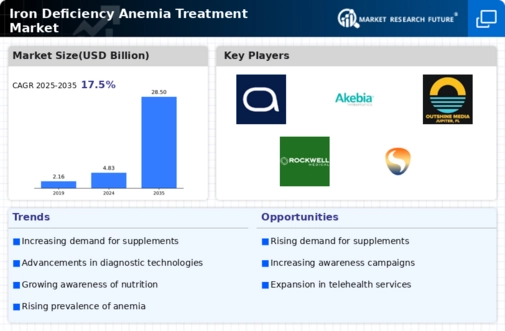Iron Deficiency Anemia Treatment Market Summary
As per Market Research Future Analysis, the Iron Deficiency Anemia Treatment Market was valued at 4.83 USD Billion in 2025 and is projected to grow to 28.47 USD Billion by 2035, with a CAGR of approximately 17.50% from 2025 to 2035. Key drivers include the rising incidence of chronic renal disease, increased risk of hem dilution in expectant mothers, and a growing prevalence of iron insufficiency. The market is primarily driven by the increasing prevalence of iron deficiency anemia, particularly among women and children, and the impact of cancer treatments on anemia rates. The oral iron therapy segment leads the market due to its ease of use, while hospitals are the largest end-user segment, benefiting from personalized treatment plans and high-quality care.
Key Market Trends & Highlights
The Iron Deficiency Anemia Treatment market is witnessing significant growth driven by various factors.
- Market Size in 2024: USD 4.83 Billion; Expected to reach USD 28.47 Billion by 2035.
- CAGR from 2025 to 2034: Approximately 17.50%; driven by rising prevalence of iron deficiency anemia.
- Oral Iron Therapy dominates the market due to ease of administration; Hospitals are the largest end-user segment.
Market Size & Forecast
| 2024 Market Size | USD 4.83 Billion |
| 2035 Market Size | USD 28.47 Billion |
| CAGR | 17.50% |
Major Players
Key players include Abbvie Inc., Akebia Therapeutics Inc., AMAG Pharmaceuticals Inc., Daiichi Sankyo Company, Pharmacosmos AS, Sanofi SA, Johnson and Johnson, and Fresenius SE & Co. KGaA.
















